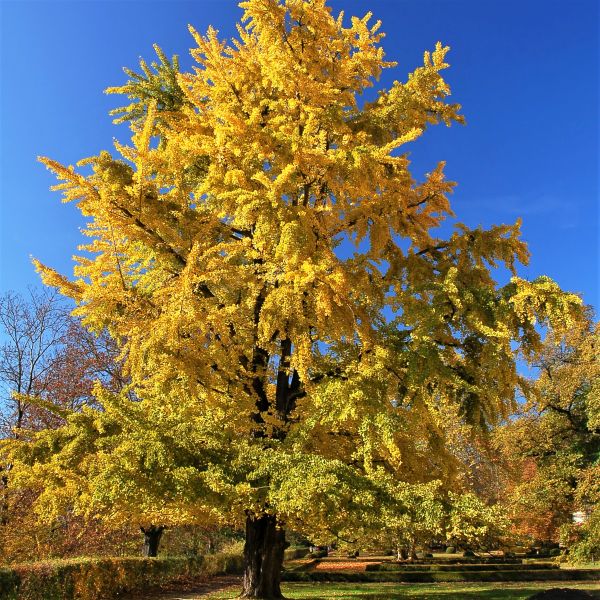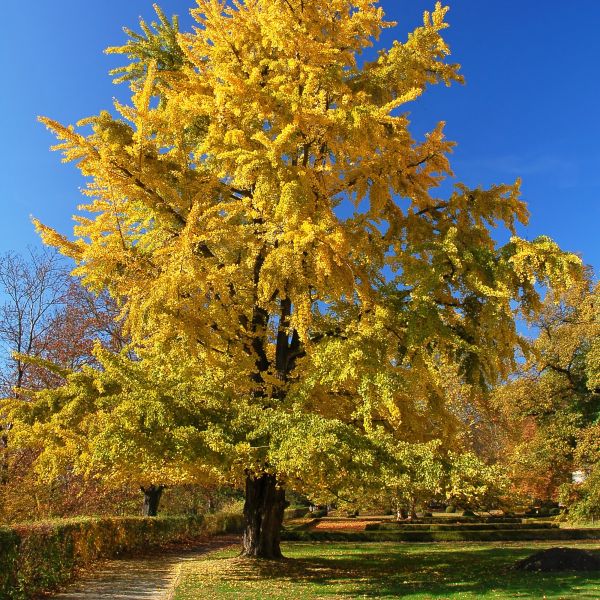


Princeton Sentry Ginkgo
Ginkgo biloba 'Princeton Sentry'
94 reviews
Princeton Sentry Ginkgo
Ginkgo biloba 'Princeton Sentry'
94 reviews
- Beautiful, fan-shaped leaves turn a stunning golden yellow in the fall
- Tolerant of urban pollution, making it a great choice for city planting
- Low maintenance and disease resistant, perfect for beginner gardeners
- Recommended by landscape designers for optimal fit in real yards
$54.00
$78.00
30% Off
- Ships to in 7-10 Days
- Free Shipping Over $150
- Plant Arrival Guarantee
- In Stock
- Free Plant Consult
$200 - Landscape-Approved: Every Plant We Sell Comes With Design Expertise Behind It
2.5 Gallon 4-5 Feet
We are sorry, product is currently out of stock due to seasonal availability. Please check the "Related plants available in your area" section below
Not just beautiful - intentionally selected by ShrubHub's 3D landscape design team to fit real-world spaces and maximize yard potential.
Why Princeton Sentry Ginkgo?
Princeton Sentry Ginkgo (Ginkgo biloba 'Princeton Sentry') is a popular choice due to its attractive upright columnar shape. This deciduous tree features unique fan-shaped leaves that turn a vibrant golden color in the fall. It is tolerant of a wide range of soil conditions and is known for its resistance to pests and diseases. The Princeton Sentry Ginkgo is a low-maintenance tree that adds beauty to any landscape.
Sunlight
The Princeton Sentry Ginkgo tree requires full sun to thrive in order to receive at least 6-8 hours of direct sunlight each day.
Watering
The watering requirement for Princeton Sentry Ginkgo is moderate. It should be watered regularly, but not excessively, to keep the soil consistently moist. Overwatering or waterlogged soil can harm the plant's roots, so proper drainage is essential.
Fertilizing
Princeton Sentry Ginkgo requires a well-balanced fertilizer, high in nitrogen, phosphorus, and potassium. It is best to consult with a local nursery or horticulturist for specific fertilizer recommendations tailored to the growing conditions and needs of t
Product Description: Princeton Sentry Ginkgo
The Princeton Sentry Ginkgo, scientifically known as Ginkgo biloba 'Princeton Sentry', is a deciduous tree highly valued for its unique and elegant qualities. This cultivar is well-adapted to urban environments, making it an excellent choice for landscaping projects in cities and residential areas.
Key Features:
- Distinctive Form: Princeton Sentry Ginkgo has a narrow, columnar shape that reaches heights of 40 to 50 feet and spreads around 15 feet wide. Its dense, upright branches create an attractive and elegant appearance that is perfect for providing vertical accents or framing entrances.
- Ginkgo Leaves: This variety boasts unique fan-shaped leaves that emerge bright green in spring and turn a vibrant golden yellow in the fall. The leaves are leathery in texture, resistant to pests and diseases, and have a graceful arrangement that adds visual interest to any landscape.
- Urban Tolerance: Princeton Sentry Ginkgo is known for its exceptional adaptability to urban conditions. It is tolerant of pollution, compacted soil, and harsh city environments, making it an ideal choice for street plantings, parks, or gardens near busy roads.
- Low Maintenance: This Ginkgo selection is relatively low-maintenance. It is drought-tolerant, adaptable to a range of soil types, and generally free from major pest or disease issues. Its strong branching structure also makes it less prone to damage from wind or storms.
Uses:
The Princeton Sentry Ginkgo is widely utilized in urban and suburban landscapes due to its versatility and aesthetic appeal. Here are some common uses:
- Street tree for urban areas
- Landscape centerpieces
- Privacy screens and windbreaks
- Ornamental specimen for parks and gardens
- Can be pruned to form an appealing hedge
Planting and Care:
When planting Princeton Sentry Ginkgo, choose a location with well-drained soil and full sun to achieve optimal growth and leaf coloration. It is adaptable to various soil types and pH levels. Regular watering during the establishment period is recommended, but once established, it becomes more tolerant of drought conditions. Pruning is generally unnecessary, but occasional maintenance pruning can help maintain its desired shape.
As with any plant, it is always recommended to refer to local gardening guidelines and consult with professionals for specific regional advice regarding care and maintenance of Princeton Sentry Ginkgo.
Please note: Availability of the Princeton Sentry Ginkgo may vary depending on location and season. Contact your nearest garden center or nursery to inquire about its availability.
Plant Information:
| Botanical Name: | Ginkgo biloba 'Princeton Sentry' |
| USDA Zones: | 3 - 8 |
| Water: | Moderate |
| Exposure: | Full Sun |
| Soil Needs: | Well Drained |
| Mature Height: | 40 - 50 feet |
| Mature Spread: | 15 - 20 feet |







Pollination Info
Pollination Information for Princeton Sentry Ginkgo (Ginkgo biloba 'Princeton Sentry')
- Botanical Name: Ginkgo biloba 'Princeton Sentry'
- Common Name: Princeton Sentry Ginkgo
Pollination Requirements:
The Princeton Sentry Ginkgo is a deciduous tree that has separate male and female trees. Only female trees produce the fleshy, foul-smelling fruit. Therefore, for the production of fruit, at least one male tree should be planted nearby to provide the necessary pollen.
Pollination Process:
The pollination of Princeton Sentry Ginkgo occurs through the transfer of pollen from the male flowers to the female flowers. The male flowers produce pollen that is carried by wind or insects, such as bees, to the female flowers. The female flowers have ovules that, when fertilized by the pollen, develop into the characteristic fruit of the ginkgo tree.
Pollination Timing:
The flowering time of Princeton Sentry Ginkgo occurs in the spring, typically in April or May, depending on the climate. Male flowers appear as small clusters of yellow catkins, while female flowers are small and inconspicuous. It is important to ensure that the male and female trees are in proximity and flower at the same time to facilitate successful pollination.
Cross-Pollination:
Cross-pollination between different cultivars of Ginkgo biloba, including Princeton Sentry, is possible and often preferred. By introducing genetic diversity through cross-pollination, it can lead to healthier trees and a better chance of fruit production.
Additional Information:
The Princeton Sentry Ginkgo, like other Ginkgo biloba cultivars, can also propagate through vegetative methods, such as grafting. However, for the purpose of pollination and fruit production, the presence of compatible male trees is essential.
FAQ
Princeton Sentry Ginkgo (Ginkgo biloba 'Princeton Sentry') - FAQ
1. What is Princeton Sentry Ginkgo?
Princeton Sentry Ginkgo (Ginkgo biloba 'Princeton Sentry') is a cultivar of the Ginkgo biloba tree. It is known for its tall, narrow, upright growth habit and distinctive fan-shaped leaves.
2. What are the characteristics of Princeton Sentry Ginkgo?
Princeton Sentry Ginkgo grows up to 60 feet in height, with a spread of about 20 to 30 feet. It has deep green leaves that turn bright yellow in the fall. The tree is highly resistant to pests and diseases and is tolerant of urban pollution.
3. How does Princeton Sentry Ginkgo prefer to be grown?
Princeton Sentry Ginkgo thrives in full sun but can tolerate some shade. It prefers well-drained soil and is adaptable to various soil types, including clay, loam, and sandy soils. It has moderate water needs and is moderately drought-tolerant.
4. What are the recommended hardiness zones for Princeton Sentry Ginkgo?
Princeton Sentry Ginkgo is hardy in USDA Zones 4-9. It can withstand cold winters and hot summers.
5. How fast does Princeton Sentry Ginkgo grow?
Princeton Sentry Ginkgo has a moderate growth rate, typically growing 12 to 24 inches per year under optimal conditions.
6. Does Princeton Sentry Ginkgo produce fruit?
No, Princeton Sentry Ginkgo is a male cultivar and does not produce fruit or seeds. Therefore, it does not create a nuisance from dropping fruit like some female Ginkgo trees.
7. How should Princeton Sentry Ginkgo be pruned?
Princeton Sentry Ginkgo generally requires little pruning. However, if necessary, it is best to prune in late winter or early spring before new growth begins. Remove any dead, damaged, or crossing branches to maintain a clean and healthy shape.
8. Are there any common pests or diseases that affect Princeton Sentry Ginkgo?
Princeton Sentry Ginkgo is highly resistant to pests and diseases. It is rarely affected by serious issues. However, occasional problems may include aphids, spider mites, or leaf spot diseases. These can be managed with appropriate insecticides or fungicides if necessary.
9. Can Princeton Sentry Ginkgo be used as a street tree?
Yes, Princeton Sentry Ginkgo is often used as a street tree due to its tolerance of urban pollution, upright growth habit, and resistance to pests and diseases. Its narrow form makes it suitable for sites with limited space.
10. Does Princeton Sentry Ginkgo have any special cultural significance?
The Ginkgo biloba tree, including the Princeton Sentry variety, has a long history and cultural significance. It is considered a living fossil and is often associated with resilience, longevity, and beauty. The unique fan-shaped leaves have inspired art and symbolism in many cultures.
Planting & Care
Planting & Care for Princeton Sentry Ginkgo (Ginkgo biloba 'Princeton Sentry')
Planting
- Choose a location with well-draining soil and full sun to partial shade.
- Dig a hole that is slightly wider and deeper than the plant's root ball.
- Place the tree gently into the hole, ensuring that it sits at the same level as it was previously planted.
- Backfill the hole with soil, firming it gently around the roots as you go.
- Water thoroughly after planting to settle the soil and eliminate any air pockets.
Watering
- Water the Princeton Sentry Ginkgo regularly, especially during dry spells or hot summers.
- Provide enough water to keep the soil evenly moist but not waterlogged.
- Be mindful not to overwater, as Ginkgo trees prefer slightly dry conditions to thrive.
Fertilizing
- Apply a balanced, slow-release fertilizer in early spring to promote healthy growth.
- Follow the package instructions for the appropriate dosage.
- Avoid fertilizing after mid-summer, as it can stimulate late-season growth that may not harden off before winter.
Pruning
- Prune the Princeton Sentry Ginkgo in late winter or early spring, while it is still dormant.
- Remove any dead, damaged, or crossing branches.
- Maintain a central leader to encourage a strong, upright growth habit.
- Avoid heavy pruning, as Ginkgo trees have a naturally attractive shape.
Pest and Disease Control
- Ginkgo trees are generally resistant to pests and diseases.
- However, some common issues include aphids, scale insects, and leaf spot diseases.
- Inspect the tree regularly and treat any infestations or diseases promptly with appropriate methods or chemical controls if necessary.
Winter Care
- Ginkgo trees are hardy and can tolerate cold temperatures.
- However, young trees may benefit from winter protection, such as mulching around the base or wrapping the trunk with burlap.
- Remove any snow buildup from the branches to prevent damage.
By following these planting and care guidelines, you can ensure the health and vigor of your Princeton Sentry Ginkgo tree.
Check Out These Verified Customer Reviews:
Customer Reviews
4.7 out of 5 based on 94 reviews
Thank you! Your review has been submitted.
The Princeton Sentry Ginkgo is a stunning tree, I couldn't be happier with how it looks in my yard. The quality is top-notch and the website was easy to use.
Ginkgo tree exceeded my expectations
The foliage on the Princeton Sentry Ginkgo is lush and full, the tree is exactly as described on the website. Very pleased with my purchase.
Item has been added to your cart.


